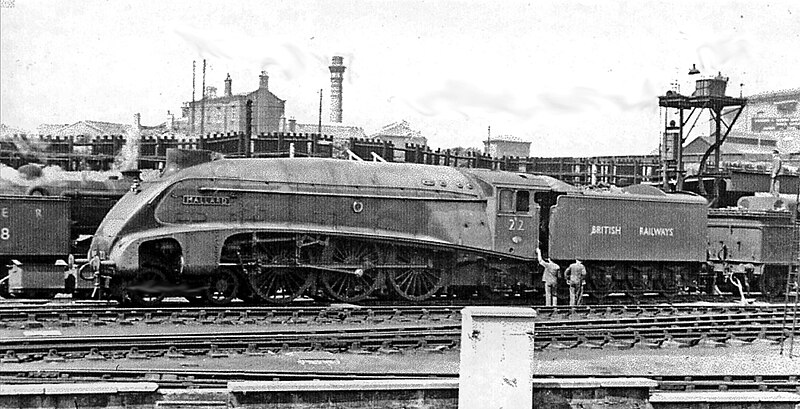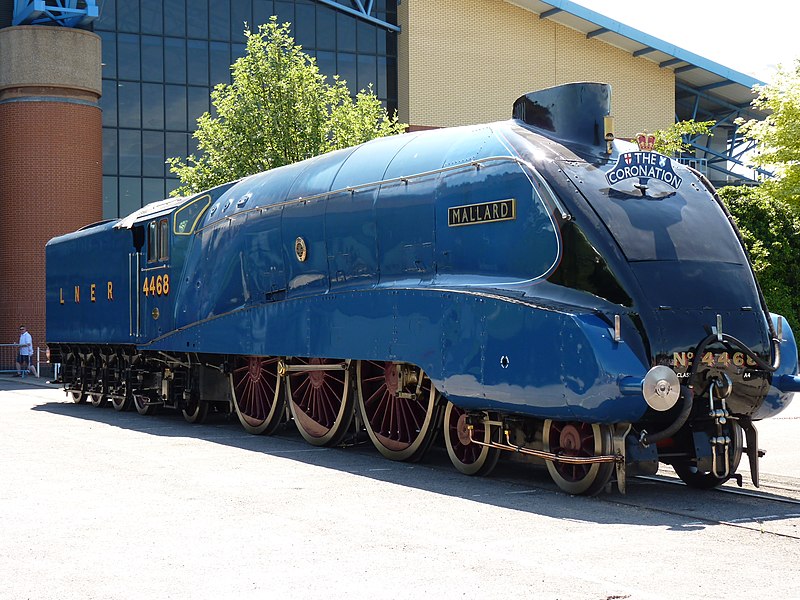Today, July 3, 2019 celebrates the 81st Anniversary of an event which has (quite literally) gone down in history in the world of Railroad/way Enthusiasts. Today, I will explain the story of Mallard: The World's Fastest Steam Locomotive.
(Note: This blog post will be written with Chicago Style. Also, I will try to keep this blog post easy to read for non train enthusiasts, but if any sections are confusing, I apologize in advance. No Copyright Infringement is intended with the photos used in this blog. )
Let's jump back to the 1930's. According to the LNER Encyclopedia, the London & North Eastern Railway, or LNER for short, were facing competition from roads and air travel. Similar to today, the solution to keep passenger trains profitable was high speed trains. The Streamliners, as the High Speed Trains of the 1930's were known, were the forerunners of trains such as the Japanese Bullet Trains and French TGV/AGV's, to name a few.
The Streamliner we will talk about today is Mallard. Mallard was built in 1938, and was 4 months old when July 3rd, 1938 came around. She is a member of the A4 class of steam locomotives, designed by Sir Nigel Gresley. The A stands for her wheel arrangement. Please look at the image of Mallard below.

Mallard in 1948, when the LNER was merged into the Government owned British Railways. Image Credit: Ben Brooksbank, used under the Wikipedia Creative Commons Licence. (This Blog is not endoresed by Ben Brooksbank). Link: https://commons.wikimedia.org/wiki/File:The_%27World%27s_Fastest_Steam_Locomotive%27_,_%27Mallard%27_with_a_transitional_number,_at_King%27s_Cross_in_1948_-_2283205.jpg
Mallard is what train enthusiasts would call a Pacific, the name given to her wheel arrangement (bare with me here): she has 4 guide wheels at the front (you can only see 2 here on her left side) 6 driving wheels and 2 trailing wheels, which supports her cab, giving her crew a smooth ride, along with the weight of the firebox, which holds the fire to put the steam in steam locomotive.
All right, let's get back to her run. July 3, 1938. Under the cover of a test run for a new break type the LNER was considering to use, the LNER used the opportunity to go for the speed record. Mallard was chosen because of how young she was, so there was less risk of mechanical failure during the attempt.
The LNER held the run in secrecy so their rival, the London Midland & Scottish Railway, or LMS, who held the British speed record at 114 mph, didn't find out. Determined to get the record, the LNER brought in driver J. Duddington, who was known, according to the LNER Enclyopedia, "had a reputation for running trains hard when it was required." To hold credibility on their run, a Dynamometer car was put onto the train. This special coach could record statistics on a locomotive's performance, in particular: their speed.
After performing the braking tests, the LNER gave the test crew a chance to leave the train. Not one person left. And so, departing from Peterborough, J. Duddington pushed Mallard to her limit. And she did not disappoint.
Mallard reached 120 mph and held this speed for several miles and then for 306 yards, she crossed over to 126! At least, that's what the Dynamometer Car reported. Gresley, while proud of his engine, felt that 125 was more accurate. In any case, Mallard's top speed beat not just the LMS's record, but also the world record for steam locomotives, which was held by the German State Railways at 124.5 mph. Close, but Mallard beat it and history was made.

Mallard at the National Railway Museum in York. Image Credit: Wikipedia User Duvda. Used under the Creative Commons Licence. (This blog is not endorsed by Wikipedia User Duvda). Link: https://commons.wikimedia.org/wiki/File:Number_4468_Mallard_in_York.jpg
Mallard unfortunately was damaged during the run, but was repaired and back in service 9 days later. The record might have been reattempted and possibly beaten, unfortunately, World War 2 broke out, halting any more speed record attempts.
Mallard was preserved because of her record, and can be seen today at the National Railway Museum of England/the UK in York. She's restored as close to her original appearance as possible, when she made that famous run. While she does not run anymore, you can sometimes see her siblings Sir Nigel Gresley and Bittern run on the mainline. Both are under restoration at centers in Crewe, according to Rail Advent and Icons of Steam. Crewe was ironically in the territory of the old LNER rival the LMS. It seems fitting that a former rival works looks after the locomotives of it's biggest competitor, showing a sense of comradery if you will. Now before you go....
Fun Facts:
1. To celebrate the 75th Anniverseary of Mallard's Speed Record, Mallard's sibling Bittern was given special permission to go above the speed limit of 75 mph for steam locomotives on the mainline in the UK today. According to Icons of Steam, Bittern set an impressive speed of 93 mph, and stayed over 90 mph for over 10 miles, proving the A4's are still as fast now as they were in the 1930's. Age does not deter a streamliner, it seems.
2. In 2013, the same year Bittern reached 93 mph, all 6 surviving A4s were reunited at the National Railway Museum, an event which was called "The Great Gathering." The trip was truly great because it saw two members, Dwight D. Eisenhower (named after the then WWII General and later President) and Dominion of Canada, return from North America!! Both Dwight and Dominion returned to America (to the US National Railway Museum, which is not at ALL confusing) and to Canada to the Exporail Canadian Railway Museum, respectively.
3. Despite Gresley feeling that 126 mph was an unfair claim, this is the number on the special Record Plates she was given. The Plates read: "On July 3, 1938 this locomotive attained a world speed record for steam traction of 126 Miles Per Hour."

Mallard's Record Plates, which she still wears. Image Credit: Wikipedia User Duvda. Used under the Creative Commons License. (This blog is not endorsed by Wikipedia user Duvda) Link: https://commons.wikimedia.org/wiki/File:Mallard_Record_Plate_01.jpg
4. Mallard's older sibling Silver Link, the prototype A4, once held the world steam speed record at 112 mph. This was later beaten by sibling Silver Fox which reached 113 mph.
5. Mallard, as you can see, was named after the duck the Mallard. According to the LNER Encyclopedia, Mallard was not the only A4 to be named after a bird. Other examples include Great Snipe, Herring Gull, Wild Swan, Falcon and preserved sibling Bittern, to name a few.
If you'ld like to learn more about the LNER A4's,check out the LNER Enclyopedia page on them. I'll leave a link in my sources section. If you're really curious (and don't mind paying around $5 US) Mr. Chris Eden-Green of Eden-Green Media has a very nice documentary on the A4's which I highly recommend, which you can watch here: www.youtube.com/watch?v=-QbHtcXOZSI
Special Thanks to Ben Brooksbanks and Duvda for their permission via Wikipedia Creative Commons License to use their photos. The copyrights of these photos belong to their respective owners. No Copyright Infringement is intended.
Thanks for reading everyone, I hope you enjoyed this look back at a moment in history. If you'd like to see more blog posts that are train related, shoot me a tweet on Twitter, @ConductorPat. Thanks for reading. Keep Writing and I'll see you on the Tramway!
Sources:
"Bittern." Icons of Steam. Accessed 3 July, 2019. www.iconsofsteam.com/locos/bittern
Holden, Michael. RailAdvent. 1st February, 2019. Accessed 3 July, 2019. "New Home for Steam Locomotive 6007 Sir Nigel Gresley."
www.railadvent.co.uk/2019/02/new-home-for-steam-locomotive-60007-sir-nigel-gresley.html
"The Gresley A4 Pacifics." LNER Enclyopedia. Accessed 3 July, 2019. www.lner.info/locos/A/a4.php

No comments:
Post a Comment